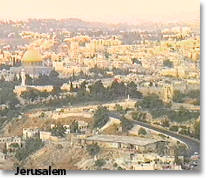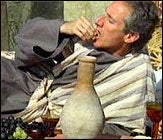The Jews celebrated their Passover Feast
in remembrance of God's deliverance from death during
the time of Moses.
Origination of Passover
 Moses had
been instructed to lead God's people out of Egypt and
save them from the evil and ungodly Pharaoh. Because
of Pharaoh's disbelief in the power of the One True
God, Yahweh sent a series of ten plagues upon the Egyptians:
the Nile turned to blood and at various times the land
was filled with frogs, gnats, flies, hail, locusts,
and darkness. In one awesome act of God's ultimate authority,
He sent one final devastating plague: every firstborn
of every household would be annihilated.
Moses had
been instructed to lead God's people out of Egypt and
save them from the evil and ungodly Pharaoh. Because
of Pharaoh's disbelief in the power of the One True
God, Yahweh sent a series of ten plagues upon the Egyptians:
the Nile turned to blood and at various times the land
was filled with frogs, gnats, flies, hail, locusts,
and darkness. In one awesome act of God's ultimate authority,
He sent one final devastating plague: every firstborn
of every household would be annihilated.
In His mercy towards His people, God would shield the Israelites from
such unmerciful judgement if they would follow the instructions He gave
to Moses and Aaron. The specific instructions are outlined in Exodus
12:1-11. In sum, each family was to take a lamb and all households were
to slaughter their lambs at the same time at twilight after a certain
number of days. Then they were commanded to paint the sides and top
of their doorways with some of this blood. Once this was done and all
the meat of the lamb was eaten in accordance with God's instructions,
God would spare the Israelites from death. This is what the Lord said:
"On that same night I will pass through Egypt and strike down every
firstborn -- both men and animals -- and I will bring judgement
on all the gods of Egypt. I am the Lord. The blood will be a sign
for you on the houses where you are; and when I see the blood, I
will pass over you. No destructive plague will touch you when I
strike Egypt. This is a day you are to commemorate; for the generations
to come you shall celebrate it as a festival to the Lord -- a lasting
ordinance" (Exodus 12:12-14).
The Seder Meal
 The highlight of a contemporary Jewish
Pesach, or Passover, is the Seder.
The highlight of a contemporary Jewish
Pesach, or Passover, is the Seder.
The Seder meal consists of six highly symbolic elements: matzah, a
roasted shank bone, parsley or green herbs, the top of a horseradish,
charoset, and an egg. On each plate are three piece of matzah (a special
type of cracker or unleavened bread). Two of these pieces represent
the traditional loaves used in the ancient Temple during festivals and
the third piece symbolizes Passover. The roasted lamb bone connotes
the sacrificial Passover lamb. Herbs symbolize springtime growth. The
horseradish represents the bitter years of slavery in Egypt; charoset,
a mixture of fruit and ground nuts soaked in wine, represents the mortar
used in Egypt; and the egg represents the chagigah (a secondary sacrifice
prepared along with the Passover lamb).
The Biblical Accounts
Accounts of what happened can be found in all four
gospels -- Matthew 26:17-27:10; Mark 14:12-72; Luke
22:1-65; John 13:1-18:27.